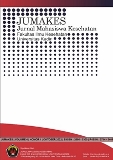Formulation of fig leaf extract (ficus carica L) as an anti-bacterial gel for acne using HPMC base
DOI:
https://doi.org/10.30737/jumakes.v3i2.2043Keywords:
Formula, gel, acne, tin leaf extract(ficus carica L), Propionibacterium acnes.Abstract
Acne is a skin disease caused by inflammation, accompanied by blockage of the sebaceous ducts of the skin. One of the causes of acne is Propionibacterium acnes. The purpose of this study is to find out whether the anti-acne gel preparation of fig leaf (Ficus Carica L) can inhibit the growth of P. acnes bacteria and has good physical stability of the preparation.
This experimental research started by the preparation of fig leaf extract with 96% ethanol dipping method, and converts it into a gel of 3 formulations with a gelling agent percentage of 2% and a HPMC concentration of 3 n 4%. The evaluation includes stability test and effectiveness test. The well diffusion method is used to inhibit the bacteria of p.acnes, and the stability test is carried out by the accelerated storage method. 10 cycles are 1 cycle, and the time span is 12 hours. The tests performed include sensory tests, uniformity, viscosity, pH, dispersion, viscosity, and syneresis. Data analysis uses a one-way analysis of variance test, followed by post-hock test.
The results of this study shows that the physical stability test of Formulation I meets all test requirements except the pH test, and Formulation II and Formulation III meet all test requirements except the viscosity test, spreadability and pH test. In antibacterial test, the antibacterial rate of formula 1 was the highest with 5.3 mm. And the analysis of variance shows that all the formulas are significantly different (p <0.05)
Â
Keywords : Formula, gel, acne, tin leaf extract(ficus carica L), Propionibacterium acnes.
Downloads
Published
Issue
Section
Deprecated: json_decode(): Passing null to parameter #1 ($json) of type string is deprecated in /home/ojs.unik-kediri.ac.id/public_html/plugins/generic/citations/CitationsPlugin.php on line 68



